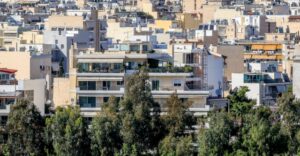The time for statements has arrived for the 21 individuals arrested and accused of participating in the Halkidiki urban planning ring. Starting this morning, they will begin to cross the “threshold” of the Polygyros investigating magistrate to provide explanations.
Against them, the head of the prosecutor’s office has filed felony charges – as applicable – for leading and participating in a criminal organization, conspiracy, bribery of officials, direct complicity in such acts, and money laundering from criminal activities.
These include four employees of the Directorate and the Building Service, two members of the Architectural Council of the Regional Unit, and 15 private individuals, most of whom have related professional activities (architects, engineers, civil engineers, surveyors). Additionally, 86 more individuals have been co-accused. These people either occasionally assisted the organizations’ activities, benefited from them (“clients”), or committed other punishable acts outside the scope of the criminal organizations’ activities.
Investigations into the case
The investigation followed reports alleging that employees of Building Services in areas of Northern Greece accepted financial benefits to permit illegal construction work and issue unauthorized building permits.
The three criminal organizations
From the Hellenic Police’s investigation and the combined evaluation of pre-investigation materials gathered, with assistance from an employee of the National Transparency Authority, the existence of three criminal organizations was confirmed. These groups have been operating at least since last May, focusing on similar illegal activities related to construction in regions of Northern Greece.
The first criminal organization
The first criminal organization, established at least by May 2024, was operationally structured, with continuous activity and distinct roles. It was directed by two employees of a Northern Greece Building Service, who, exploiting their positions, coordinated the 14 other members of the organization to perform actions or omissions linked to – or sometimes contrary to – their official duties. In some instances, they forced interested citizens to pay bribes or larger sums under the threat of halting bureaucratic procedures or citing other excuses (e.g., incomplete documentation, heavy workload).
The two “leaders” of this organization, due to their long tenure and exploiting both the inherent dysfunctions in the operation of the Building Service (the labyrinthine legal framework, delays citing heavy workloads and staff shortages) and the rapid growth of construction in their jurisdiction – including interest from foreign investors – developed corrupt dealings. They recruited specific private engineers to handle bureaucratic procedures for clients, demanding or receiving bribes from private professionals.
Beyond coordinating the organization’s actions, they also participated in its activities, individually or jointly, using their roles and positions to perform specific actions for issuing administrative acts. The first, as a supervisor and civil engineer, ensured the assignment of pertinent applications either to himself or to the second leader, who, as a responsible employee and surveyor, checked topographical diagrams and made corrections as needed to legitimize the administrative acts issued illegally.
These leaders had even created a “price list” for the bribes they demanded, depending on the type of administrative act they undertook. For instance, the bribes ranged from €150 to €1,000 for prioritizing administrative acts and from €1,000 to €20,000 for issuing acts bypassing legal procedures.
The organization’s members showed particular caution, taking protective measures such as hiding bribes in folders and using coded language during communications, with terms like “plans,” “eggs,” “geese,” “paper,” and “acres” for money, and “fingers” to indicate bribe amounts.
The second criminal organization
The second criminal organization was established at least by August 2024 and operated until December 10, 2024, when arrests were made.
This group consisted of two individuals: a Building Directorate employee and a private engineer. The former handled bureaucratic procedures, including issuing building permits, inspecting illegal constructions, conducting on-site inspections, and imposing penalties. The latter handled cases involving unauthorized constructions, ensuring favorable outcomes for clients in violation of legal provisions.
The cases fell into two categories:
Unauthorized constructions built after 2011 that were falsely declared as existing before 2011 under the favorable provisions of Law 4495/2017, avoiding fines for their erection and maintenance.
Constructions planned in violation of regulations, which were given legitimacy through alternative administrative acts to bypass penalties.
In at least 14 documented cases, the private engineer demanded or received illicit financial benefits totaling €59,800.
The third criminal organization
The third organization, active from at least July 2024, involved two members of the Architectural Council of a Northern Greece Regional Unit and a private engineer. They ensured council approvals for architectural studies, fabricated council minutes, and submitted these for building permits.
In some instances, this organization collaborated with leading members from the first and second organizations, highlighting their overlapping activities.
So far, investigations have revealed the involvement of all three organizations in at least 92 cases, with bribes exceeding €213,100.
Ask me anything
Explore related questions





